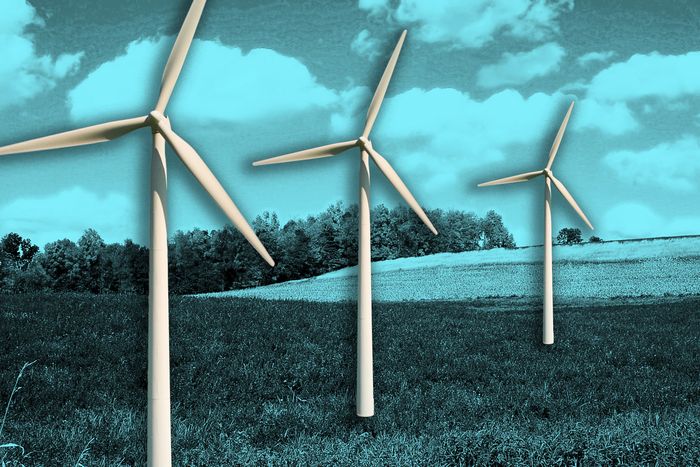
Jim Simon, the grizzled town supervisor of Yates, New York, thinks of himself as a “reluctant warrior” in the wind-turbine fight. Raised in Buffalo, Simon spent over 20 years in the Air Force before settling down in Yates in 2005 and taking up work at Genesee Community College, where he taught history and later became a dean. As Simon tells it, he never had any political ambitions until early 2015, shortly after the Virginia-based wind developer Apex Clean Energy came to town with a proposal for the Lighthouse Wind Project — at least 47 turbines near Lake Ontario, enough to potentially power 53,000 homes. To Simon, it seemed more like an ambush: By the time he’d heard the details, Apex had already begun buying up leases from individual landowners in and around Yates and Somerset, small farming towns with a combined population of about 5,000. Some locals formed an opposition group, Save Ontario Shores (SOS), that quickly accrued so much support that, by year’s end, it managed to get Simon elected through an almost single-issue write-in campaign. (“Simon wouldn’t go away,” an editor at a local news outlet wrote of his rise.)
SOS’s complaints attacked the turbines from every angle, alleging a possible impact on property values, potential bird deaths owing to migratory patterns, noise pollution, and “shadow flicker” — a phenomenon where the sun casts shadows through rotating turbines. And then there was the feeling that wealthy communities in energy-guzzling cities were “exploiting rural resources to suit urban needs,” says Gary Abraham, a lawyer for SOS. Not helping matters, the proposed turbines were also big, standing at about 591 feet, dwarfing even the tallest building in Buffalo and reaching heights typically associated with offshore turbines. (“Too big, too close,” reads a popular lawn sign made by SOS.) As even Abraham will admit, objection to wind turbines often starts as an aesthetic judgment — a starting point from which opponents then drill down into other complaints. But what if we could change the way turbines look?
The battle in Yates and Somerset mirrored similar ones across rural New York, where opponents of wind projects have grown increasingly paranoid about encroaching developers as the state has accelerated its efforts to get renewable-energy projects approved. (While reaching out to locals about the Bluestone Wind Farm in Broome County, I was accused of having conflicts of interest, which came as a surprise to me until I realized the source of confusion: A project manager for the wind farm is also named Chris Stanton.) One state over, the future of offshore wind development on the East Coast may be decided by the outcome of a standoff in Ocean City, New Jersey, where locals insist that turbines will disrupt their views and kill whales — mimicking talking points from a nonprofit run by a former DuPont executive who advises right-wing think tanks and was part of former president Trump’s Environmental Protection Agency transition team. (The local anti-wind group in Ocean City, meanwhile, warns of the dangers of “big-wind propaganda.”)
Various designs have emerged over the last 150 years, but the most common industrial-scale turbine used to generate electricity these days is the horizontal-axis wind turbine, which was first used in 1931 and is named for the way its rotational axis runs parallel to the direction of the wind. (If you’ve ever driven past a commercial wind farm — such as the famous one outside Palm Springs, California — it was probably composed of three-bladed HAWTs.) By a wide margin, HAWTs are the most efficient turbines, and they’ll only become more so as technology allows them to get bigger — making the blades longer has exponential benefits to the amount of power they produce, and building the towers taller allows the turbines to harness more powerful winds. As turbines continue to grow, the debate over their aesthetic impact will only intensify, especially if they proliferate at a rate that allows New York to meet its goal of drawing 70 percent of its electricity from renewable-energy sources by 2030. How, then, can developers appease locals worried about supposedly industrial wind farms taking over their idyllic landscapes? If other forms of infrastructure offer any clues, the answer might be trying to hide the fact that they’re wind farms at all.
There’s a long tradition of communities disguising their own infrastructural needs — think, for instance, of the Brooklyn Heights brownstone that’s actually an MTA vent, or the unconvincing palm-tree cell towers that dot Southern California. But in looking for examples of how to aesthetically mitigate industrial-scale energy production, there might be something to learn from an unexpected source: the oil industry. In the early 1960s, a consortium of major oil companies set its sights on a reserve just off the coast of Long Beach, California. For years, locals had debated the best course of action for the oil, eager to exploit the financial benefits but also wary of some of the consequences of drilling. Ugly derricks had already overrun nearby Signal Hill, and Long Beach itself had been so ravaged by oil drilling in previous decades that parts of the city began sinking into the ocean, leading Time magazine to label it “America’s Sinking City” in 1956. That same year, locals voted to ban oil drilling in Long Beach, only to reverse course in 1962, but with a caveat: Any offshore drilling operations had to be disguised as something else. (Six years was apparently enough time to get over the whole “sinking city” thing.) Two years later, the city of Long Beach set to work on the THUMS oil islands, named collectively for the five oil companies that would operate them: Texaco, Humble, Union, Mobile, and Shell. (A confusing moniker, given that there are only four islands and that individually, each of the islands is named after an astronaut.)
Unafraid of a little kitsch, Long Beach officials suggested the islands should be modeled after tropical islands in the South Pacific — an idea that landscape architect Joseph Linesch mercifully vetoed. Linesch, who had worked on Disneyland and had already disguised smaller oil sites (one as a lighthouse in Venice Beach and the other as a high-rise in Beverly Hills), suggested the islands should look like an extension of downtown Long Beach. Metal shells resembling high-rises would disguise drilling rigs, while palm trees would reinforce the illusion and waterfalls would help mitigate noise. The result was a Disneyland-esque simulacrum of an island resort — not quite a convincing illusion, but certainly a less disruptive sight than a standard oil rig. Trade publications were quick to call the project a success, and Linesch ominously declared, “We’ve just proved that oil and people do mix.” (Less than a year after the islands were completed, the 1969 Santa Barbara oil spill devastated the coastline a few hours to the north.)
At a much smaller scale, organizations like the Land Art Generator Initiative have developed clever means of aesthetically integrating wind energy into public spaces. For instance, LAGI has built multiple iterations of the WindNest, the latest of which resides on a retired oil rig in the U.K.’s North Sea. A combination public-art piece and wind-energy generator, the spinning structure (designed by artist Trevor Lee) is intended to drive conversation about renewable energy and how it can be deployed in urban spaces that can’t accommodate industrial-scale wind farms. While LAGI co-founder Robert Ferry hopes the installation inspires the public, he says its output is only enough to power about two British homes each year, while a single onshore turbine can power 2,500 and some offshore ones can power 18,000. (American households, unsurprisingly, consume more than double the energy that British ones do.)
“We’re going to have to understand that horizontal-axis wind turbines aren’t going away,” Ferry says.
And what if trying to disguise wind farms is missing the point, anyway? In her book Aesthetics of the Familiar: Everyday Life and World-Making, Rhode Island School of Design professor emeritus Yuriko Saito — who first wrote about wind-turbine aesthetics back in 2004 — outlines the distinction between “thin” and “thick” aesthetic qualities. An object’s thin qualities are simply its surface-level characteristics, which you can observe with your own two eyes. Assessing an object’s thick qualities, meanwhile, requires incorporating outside knowledge: whether the object was ethically made, what purpose it serves, etc. In designing the oil islands, Linesch succeeded in finding a cosmetic solution to the ugliness of oil production, but the islands’ thick aesthetic qualities — say, their environmental impact — could lead you to view them as ugly anyway.
“There’s no integrity between the design considerations of the THUMS and the operations taking place there,” says James Nisbet, an art historian and UC Irvine professor who’s writing a book that features the islands. “The aesthetics existed to keep people from asking questions about what was really going on behind the scenes.”
By contrast, the aesthetics of wind turbines are brutally honest: You can see how they function just by watching them spin. If that sight isn’t beautiful to you, the knowledge that they’re creating renewable energy might help. “I feel good when I see wind turbines,” says Scott Lauffer, a member of the Sierra Club environmental group who lives a 30-minute drive from the Bluestone Wind Farm. “I say, ‘There’s clean energy.’”
For their detractors, though, wind farms may represent too emotional of an issue to be persuaded by an academic conversation about aesthetics. “Landscapes are being transformed in people’s minds in terms of the meanings they have for them,” says Rich Stedman, a Cornell professor specializing in natural resources and the environment. Wind-farm opponents, including members of SOS, often emphasize that they support renewable energy even if they take issue with a specific project, and contend that their instinct to protect local ecology amounts to its own form of environmentalism. “There’s no free lunch, right?” Stedman points out. “If we’re transitioning as a state to increase dependence on renewables, it does have to go somewhere.” As these battles continue to unfold across New York and elsewhere, Stedman and others in his field agree that the best course of action for developers is to engage with communities early and often, creating more financial incentives where necessary and compromising on issues like where individual turbines are sited. Long term, turbines’ thick qualities may even allow them to age well, aesthetically speaking — or at least “that’s the hope,” Saito says.
As far as Simon and SOS are concerned, that conversation might be moot. Last year, they prevailed in their campaign against the Lighthouse Wind project — Apex announced it was no longer seeking a permit. While the state of New York only has one potential onshore wind farm under review at the moment (the Prattsburgh wind project in Steuben County), Simon knows that another developer might someday scope out Yates as a possible wind-farm site. If they do, he says, “I would make the plea they do it the right way. Come in and have a conversation.” Whether or not that would work, he’s not sure — the same old sticking points might arise anyway. “Some people were really mad about the aesthetics, certainly,” he says. “Who wants a spinning turbine out there half a mile from their house 24/7, you know?”





